Regional Gardens Cloud Architectures: A Survey
35 Pages7774 Words328 Views
Added on 2021-05-31
About This Document
Cloud Computing Cloud Computing Cloud Computing Cloud Computing Student Name University Name Date: Executive Summary This report highlights suitable cloud architectures that Regional Gardens must employ to achieve its business strategy. Contents Contents 3 Introduction 4 Part 1 4 Cloud architectures employ to assist Regional Gardens in meeting the Board's strategy 4 Cloud Architectures for Regional Gardens 5 Benefits and issues result of deployment of these architectures for Regional Gardens 6 Part 2 8 Risks associated with Hybrid Cloud and Microservices strategy 9 Each risk 12 Possible control for the risk 13
Regional Gardens Cloud Architectures: A Survey
Added on 2021-05-31
ShareRelated Documents
Running head: Cloud Computing
Cloud Computing
Student Name
University Name
Date:
Cloud Computing
Student Name
University Name
Date:
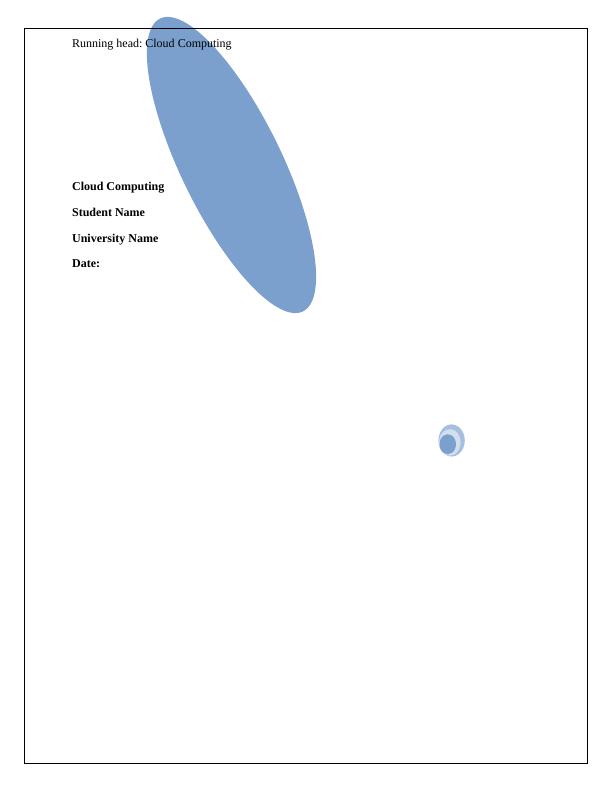
Cloud Computing
Executive Summary
This report highlights suitable cloud architectures that Regional Gardens must employ to achieve
its business strategy. Benefits and issues of deploying cloud architectures are also included in
this report. Risks that are associated with new Microservices strategy and Hybrid Cloud are
included in this report. General Information protection steps as well as controls for hybrid cloud
infrastructure are also highlighted in this report. Recommendations for Regional Gardens’ BCP
are also discussed in this report. Remote server administration for the resource management
along with SLA management for PaaS and IaaS and instances required for Regional Gardens
also included in this report.
2 | P a g e
Executive Summary
This report highlights suitable cloud architectures that Regional Gardens must employ to achieve
its business strategy. Benefits and issues of deploying cloud architectures are also included in
this report. Risks that are associated with new Microservices strategy and Hybrid Cloud are
included in this report. General Information protection steps as well as controls for hybrid cloud
infrastructure are also highlighted in this report. Recommendations for Regional Gardens’ BCP
are also discussed in this report. Remote server administration for the resource management
along with SLA management for PaaS and IaaS and instances required for Regional Gardens
also included in this report.
2 | P a g e

Cloud Computing
Contents
Contents...........................................................................................................................................3
Introduction......................................................................................................................................4
Part 1................................................................................................................................................4
Cloud architectures employ to assist Regional Gardens in meeting the Board's strategy...............4
Cloud Architectures for Regional Gardens......................................................................................5
Benefits and issues result of deployment of these architectures for Regional Gardens..................6
Part 2................................................................................................................................................8
Risks associated with Hybrid Cloud and Microservices strategy....................................................9
Each risk........................................................................................................................................12
Possible control for the risk...........................................................................................................13
Part 3..............................................................................................................................................15
General Information Security steps and controls...........................................................................15
Part 4..............................................................................................................................................19
Recommendations included in Regional Gardens’s BCP.............................................................19
Application resilience, disaster recovery and backup issues in Hybrid Cloud..............................21
Part 5..............................................................................................................................................24
Requirements for Remote Server Administration.........................................................................24
SLA associated with storage..........................................................................................................24
Part 6..............................................................................................................................................28
Conclusion.....................................................................................................................................29
References......................................................................................................................................31
3 | P a g e
Contents
Contents...........................................................................................................................................3
Introduction......................................................................................................................................4
Part 1................................................................................................................................................4
Cloud architectures employ to assist Regional Gardens in meeting the Board's strategy...............4
Cloud Architectures for Regional Gardens......................................................................................5
Benefits and issues result of deployment of these architectures for Regional Gardens..................6
Part 2................................................................................................................................................8
Risks associated with Hybrid Cloud and Microservices strategy....................................................9
Each risk........................................................................................................................................12
Possible control for the risk...........................................................................................................13
Part 3..............................................................................................................................................15
General Information Security steps and controls...........................................................................15
Part 4..............................................................................................................................................19
Recommendations included in Regional Gardens’s BCP.............................................................19
Application resilience, disaster recovery and backup issues in Hybrid Cloud..............................21
Part 5..............................................................................................................................................24
Requirements for Remote Server Administration.........................................................................24
SLA associated with storage..........................................................................................................24
Part 6..............................................................................................................................................28
Conclusion.....................................................................................................................................29
References......................................................................................................................................31
3 | P a g e
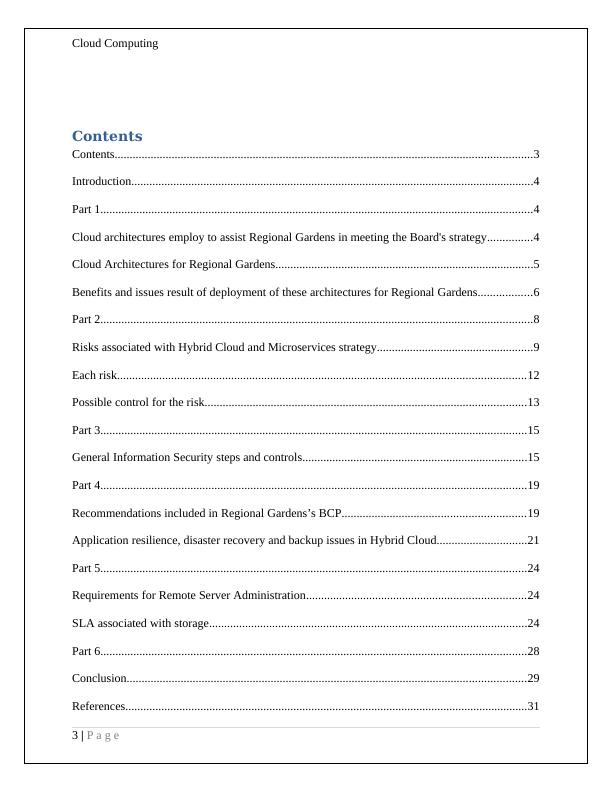
Cloud Computing
Introduction
Regional Garden Co., Ltd. Company operates a large number of gardening companies. It has a
very large display of gardening products and is open every year for public inspection. This
includes public and regional landscape planners providing garden advice, design and consultancy
services to Regional garden nursery sales plants and garden supplies. The regional garden board
is considering this strategy to improve the company's responsiveness and flexibility. The council
also hopes to significantly reduce the expenses of maintaining its ICT framework by closing its
existing data center. They understand that this requires the retraining of existing ICT personnel
so that they can manage the new cloud-based infrastructure. The regional gardens contact you
again and advise them on this strategy. It has been suggested to the Regional Gardens that this
planned approach means that they ultimately need to easily design as well as operate a "hybrid
cloud" approach where some of the data centers are "on-premise" and the other is the cloud.
Regional Garden also plans to organize risk and safety seminars to assess the risks, safety issues
and possible controls needed for this "hybrid cloud" approach. This study includes how this
approach will affect its BCP and its backup as well as disaster recovery strategy.
Part 1
Cloud architectures employ to assist Regional Gardens in meeting the Board's
strategy
Cloud architecture shows different components such as databases, software functions, and
applications. Its purpose is to use the power of cloud resources to solve business problems.
Defines cloud architecture companies as well as their relationships. The entire cloud architecture
4 | P a g e
Introduction
Regional Garden Co., Ltd. Company operates a large number of gardening companies. It has a
very large display of gardening products and is open every year for public inspection. This
includes public and regional landscape planners providing garden advice, design and consultancy
services to Regional garden nursery sales plants and garden supplies. The regional garden board
is considering this strategy to improve the company's responsiveness and flexibility. The council
also hopes to significantly reduce the expenses of maintaining its ICT framework by closing its
existing data center. They understand that this requires the retraining of existing ICT personnel
so that they can manage the new cloud-based infrastructure. The regional gardens contact you
again and advise them on this strategy. It has been suggested to the Regional Gardens that this
planned approach means that they ultimately need to easily design as well as operate a "hybrid
cloud" approach where some of the data centers are "on-premise" and the other is the cloud.
Regional Garden also plans to organize risk and safety seminars to assess the risks, safety issues
and possible controls needed for this "hybrid cloud" approach. This study includes how this
approach will affect its BCP and its backup as well as disaster recovery strategy.
Part 1
Cloud architectures employ to assist Regional Gardens in meeting the Board's
strategy
Cloud architecture shows different components such as databases, software functions, and
applications. Its purpose is to use the power of cloud resources to solve business problems.
Defines cloud architecture companies as well as their relationships. The entire cloud architecture
4 | P a g e
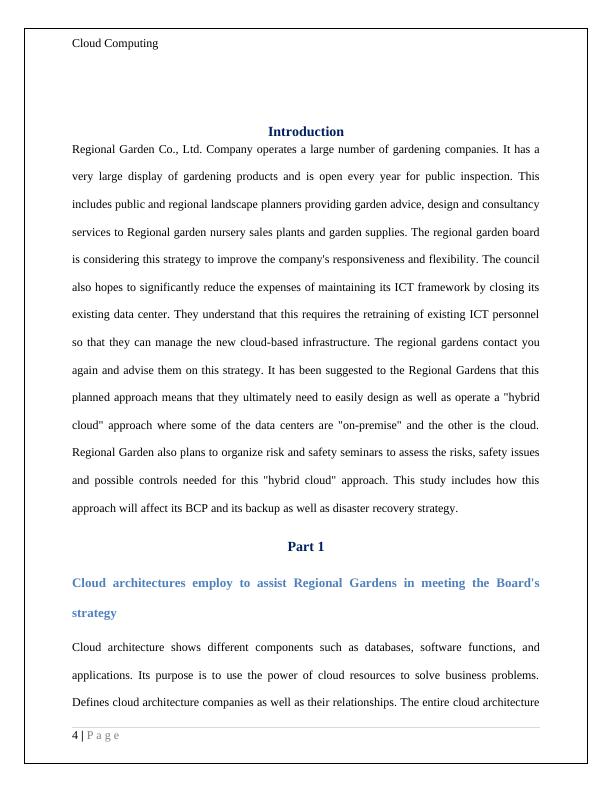
Cloud Computing
is designed to provide users with high bandwidth, allowing users to gain access to data and to
applications without interruption (Cowan, 2011). On-demand responsive networks can move
efficiently and quickly between servers and even between clouds, the most important being
network security. The large number of cloud-based building blocks selected by Regional Garden
Co., Ltd. has brought new possibilities to the cloud architecture and brought new challenges.
Cloud architecture begins with sticking to the familiar concepts of local architecture. Cloud
computing is public computing based on the Internet, basically sharing software, resources, and
information used by the end users that are hosted on a virtual server. Few people call anything
outside the company or user's private firewall as the cloud (Lang & Schreiner, 2011). Personal
computing has been developed in three different phases. The very first stage is where data and
applications are stored on the local desktop. Next phase is the application resides on the desktop
with local servers moreover utility software as well as the Internet to provide valuable
information. From the day of the popular Internet usage, Network Architecture illustrates the
Internet as a cloud so that the end can hide the user's complexity - hence the name is called
Cloud Computing resides in services as data centers with application or software server forms
and redundant storage. Finally users can access them through a web browser in a laptop or
handheld device. Google Apps, Salesforce and Facebook are examples of cloud computing,
especially for younger generations, which are quite popular (Lang & Schreiner, 2011).
Cloud Architectures for Regional Gardens
Reasons to Choose SaaS
The SaaS model is widely used a cloud model. Regional Gardens needs to build its career
development in several aspects. Therefore, for this situation, SaaS is best service modes based on
the following important features: So as to increase the efficiency of the company for all the
5 | P a g e
is designed to provide users with high bandwidth, allowing users to gain access to data and to
applications without interruption (Cowan, 2011). On-demand responsive networks can move
efficiently and quickly between servers and even between clouds, the most important being
network security. The large number of cloud-based building blocks selected by Regional Garden
Co., Ltd. has brought new possibilities to the cloud architecture and brought new challenges.
Cloud architecture begins with sticking to the familiar concepts of local architecture. Cloud
computing is public computing based on the Internet, basically sharing software, resources, and
information used by the end users that are hosted on a virtual server. Few people call anything
outside the company or user's private firewall as the cloud (Lang & Schreiner, 2011). Personal
computing has been developed in three different phases. The very first stage is where data and
applications are stored on the local desktop. Next phase is the application resides on the desktop
with local servers moreover utility software as well as the Internet to provide valuable
information. From the day of the popular Internet usage, Network Architecture illustrates the
Internet as a cloud so that the end can hide the user's complexity - hence the name is called
Cloud Computing resides in services as data centers with application or software server forms
and redundant storage. Finally users can access them through a web browser in a laptop or
handheld device. Google Apps, Salesforce and Facebook are examples of cloud computing,
especially for younger generations, which are quite popular (Lang & Schreiner, 2011).
Cloud Architectures for Regional Gardens
Reasons to Choose SaaS
The SaaS model is widely used a cloud model. Regional Gardens needs to build its career
development in several aspects. Therefore, for this situation, SaaS is best service modes based on
the following important features: So as to increase the efficiency of the company for all the
5 | P a g e
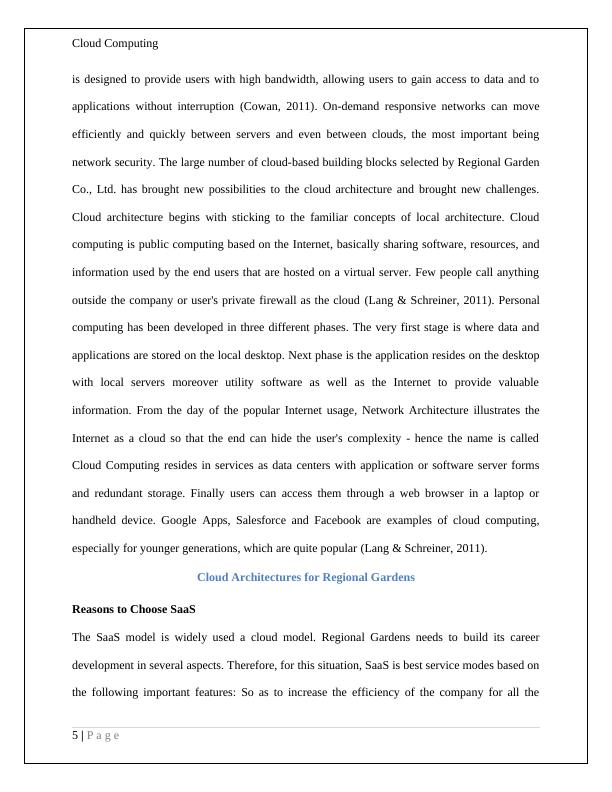
Cloud Computing
remote regions and overseas missions Regional Gardens must use SaaS which is one of suitable
option for dealing with problems that may be encountered (Pathari & Sonar, 2012). This includes
service management, security, and the integration of organizational operations, which seems to
be smoother and easier than any other traditional approach. When migrating all data centers to
one single host location (where all is controlled and centralized from a node), cost minimization
can be handled very efficiently. All the tasks of processing software as well as related
deployments are controlled by any third-party vendor (Wang & Hou, 2011).
Reasons for using PaaS
Since the applications and data are locally managed and the third-party vendors have a high level
of control, it is critical to train employees to migrate data from the Regional Garden data center
to other data centers. Many security and Consistency of the data may be affected, resulting in
data loss. In order to overcome shortcomings, SaaS is the main choice and makes operations
easier and more flexible (Lin & Huang, 2016).
Benefits and issues result of deployment of these architectures for Regional Gardens
Benefits to using SaaS
When Regional Garden Co., Ltd. adapts to SaaS, there are several advantages in making internal
management easier to operate.
• Higher reliability as well as the availability
• Reduce management work
• Collaboration across large business areas
• Zero infrastructure
• Provide a high level of services
6 | P a g e
remote regions and overseas missions Regional Gardens must use SaaS which is one of suitable
option for dealing with problems that may be encountered (Pathari & Sonar, 2012). This includes
service management, security, and the integration of organizational operations, which seems to
be smoother and easier than any other traditional approach. When migrating all data centers to
one single host location (where all is controlled and centralized from a node), cost minimization
can be handled very efficiently. All the tasks of processing software as well as related
deployments are controlled by any third-party vendor (Wang & Hou, 2011).
Reasons for using PaaS
Since the applications and data are locally managed and the third-party vendors have a high level
of control, it is critical to train employees to migrate data from the Regional Garden data center
to other data centers. Many security and Consistency of the data may be affected, resulting in
data loss. In order to overcome shortcomings, SaaS is the main choice and makes operations
easier and more flexible (Lin & Huang, 2016).
Benefits and issues result of deployment of these architectures for Regional Gardens
Benefits to using SaaS
When Regional Garden Co., Ltd. adapts to SaaS, there are several advantages in making internal
management easier to operate.
• Higher reliability as well as the availability
• Reduce management work
• Collaboration across large business areas
• Zero infrastructure
• Provide a high level of services
6 | P a g e

Cloud Computing
• Work anytime, anywhere
• Enduring customer relationships
• Data recovery and Backup
Issues to use SaaS
Although there are several advantages to applying Regional Gardens Ltd to the SaaS cloud
service model, there is an obligation to restrict end users from considering changing their
traditional infrastructure to a new service model (Gluchman, 2016).
• Access control loss
• Limited application
• Connection requirements
• Bit slowly as compared to client/server apps
• Additional training costs for employees to adapt to the new system
• Data security is always controlled by third-party vendors and is not 100% trustworthy
• Terminating the switch between supplier contracts and SaaS providers
• More dependent on the internet.
Benefits to using PaaS
• It is very clear from these descriptions of PaaS platform that developers have many options.
• Initially, developing applications on the PaaS platform greatly reduce the time as well as
resources needed to develop the cloud-based applications (Zúñiga-Prieto, González-Huerta,
Insfran & Abrahão, 2016). By providing a higher level of service, developers can always take
benefits of out-of-the-box functionality without having to spend time re-creating these services.
Issues to use PaaS
7 | P a g e
• Work anytime, anywhere
• Enduring customer relationships
• Data recovery and Backup
Issues to use SaaS
Although there are several advantages to applying Regional Gardens Ltd to the SaaS cloud
service model, there is an obligation to restrict end users from considering changing their
traditional infrastructure to a new service model (Gluchman, 2016).
• Access control loss
• Limited application
• Connection requirements
• Bit slowly as compared to client/server apps
• Additional training costs for employees to adapt to the new system
• Data security is always controlled by third-party vendors and is not 100% trustworthy
• Terminating the switch between supplier contracts and SaaS providers
• More dependent on the internet.
Benefits to using PaaS
• It is very clear from these descriptions of PaaS platform that developers have many options.
• Initially, developing applications on the PaaS platform greatly reduce the time as well as
resources needed to develop the cloud-based applications (Zúñiga-Prieto, González-Huerta,
Insfran & Abrahão, 2016). By providing a higher level of service, developers can always take
benefits of out-of-the-box functionality without having to spend time re-creating these services.
Issues to use PaaS
7 | P a g e
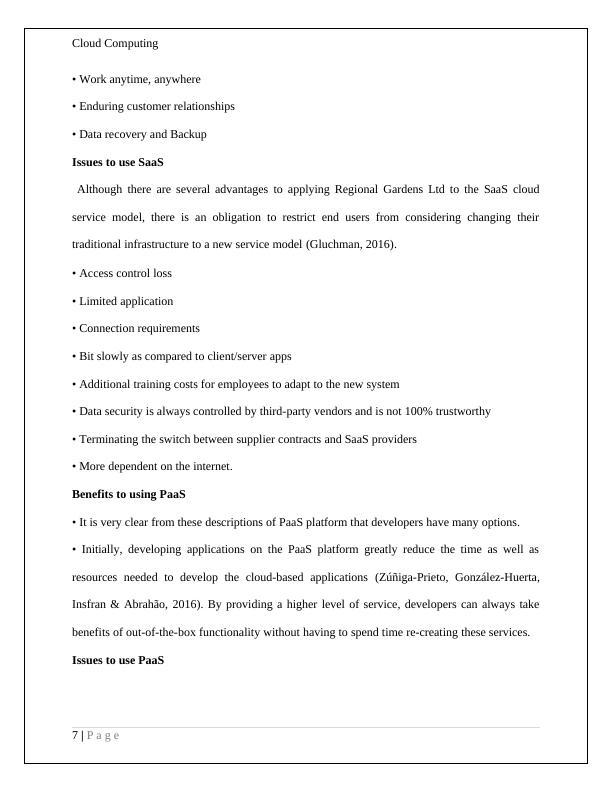
Cloud Computing
• Because the PaaS platform gives a higher level of programming framework and abstraction, it
can accelerate the development of some cloud-based applications and migrate existing SaaS-
based applications to the cloud (Abu Sharkh & Shami, 2017). However, these advantages are
some costs for developers. Balanced costs and benefits indicate the use of the situation for the
use of PaaS, when this is not a case.
• The first challenge for PaaS is a lookout platform. With the use of higher-level service and
programming models, the dependence on these services and access methods depends on these
services.
Part 2
The hybrid cloud computing model is an integrated service model that comprehensively uses
public as well as private clouds in order to perform several operations associated with regional
garden organizations. Public clouds will be used for all the non-sensitive information and
operations, and private service cloud models for sensitive operations related to internal
operations (Pahl, Jamshidi & Weyns, 2017).
8 | P a g e
• Because the PaaS platform gives a higher level of programming framework and abstraction, it
can accelerate the development of some cloud-based applications and migrate existing SaaS-
based applications to the cloud (Abu Sharkh & Shami, 2017). However, these advantages are
some costs for developers. Balanced costs and benefits indicate the use of the situation for the
use of PaaS, when this is not a case.
• The first challenge for PaaS is a lookout platform. With the use of higher-level service and
programming models, the dependence on these services and access methods depends on these
services.
Part 2
The hybrid cloud computing model is an integrated service model that comprehensively uses
public as well as private clouds in order to perform several operations associated with regional
garden organizations. Public clouds will be used for all the non-sensitive information and
operations, and private service cloud models for sensitive operations related to internal
operations (Pahl, Jamshidi & Weyns, 2017).
8 | P a g e
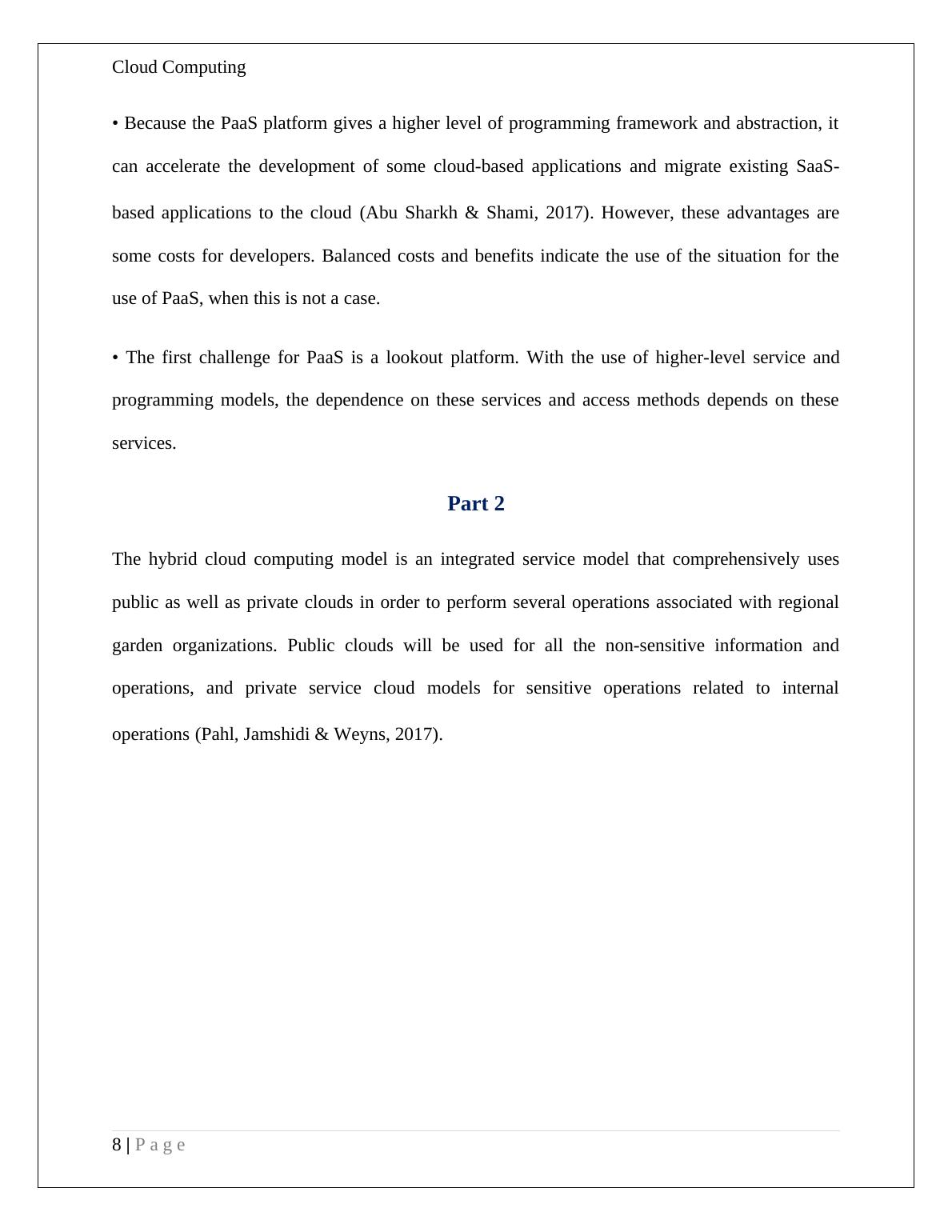
End of preview
Want to access all the pages? Upload your documents or become a member.
Related Documents
qwertyuiopasdfghjklzxcvbnmqwertyuiopasdfghjklzxcvbnmqwertyuiopasdfghjklzxcvbnmqwertyuiopasdfghjklzxcvbnmqwertyuiopasdfghjklzxcvbnmqwertyuiopasdfghjklzxccvbnmqqwertyuiopasdfghqqwertyuioplg...
|23
|7203
|209
BCP for Adopting Hybrid Cloud and Microservices Approachlg...
|8
|1319
|395
Cloud Computinglg...
|16
|4280
|141
Security Management and Migration: Assignmentlg...
|31
|6909
|100
Recommendations for MetaSoft's Migration to Cloud Computinglg...
|14
|2720
|384
The Regional Garden Companylg...
|30
|7288
|345
